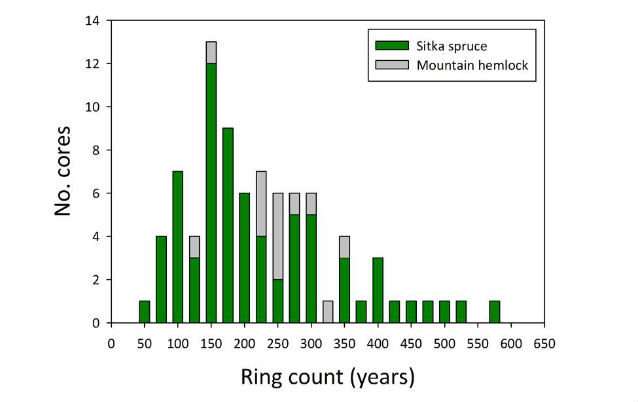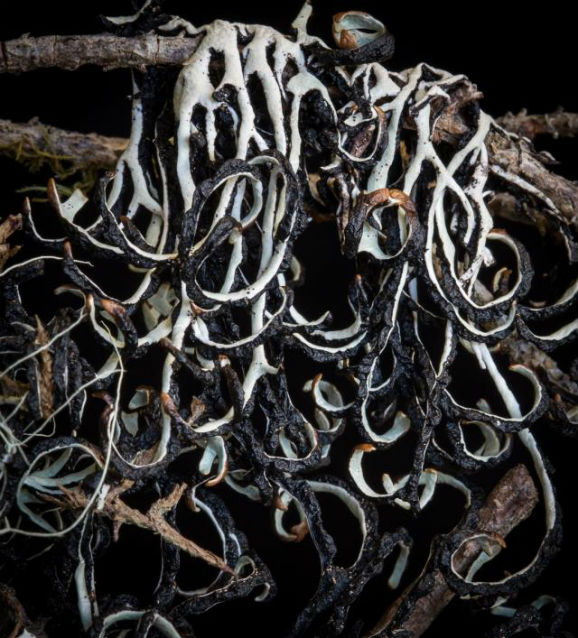Importance

NPS/James Walton
Kenai Fjords National Park (NP) is well known for its dramatic coastal scenery, and the park’s forests are one of the prominent features of this landscape. Vegetation patterns in the park are shaped by physical factors including topography, climate, substrate (soils and geology), and disturbance (such as avalanches or pests). Changing environmental conditions including a warming climate and increasing climate variability, shifting atmospheric chemistry and pollutant loads, and increasing variability in plant diseases and pests are expected to affect vegetation throughout Alaska in the future. An important priority for Kenai Fjords NP is to monitor its coastal forests for these changes. Measuring the relationships between these environmental conditions and coastal forest growth will help to better understand how ecological change may affect park resources.
The image below shows a shoreline view of a mature Sitka spruce-mountain hemlock forest at Square Bay (A), and a view of the understory vegetation at Chance Cove (B). Defoliator damage on huckleberry at Chance Cove resulted in extensive dieback of the existing branches in 2013, shown in the foreground (B). Many shrubs are starting to re-sprout at the base. Both sites are near McArthur Pass, on the East Arm of Nuka Bay.
Methods

NPS\James Walton
In order to assess future changes to Kenai Fjord’s forests, nine monitoring plots were established in 2013 in mature Sitka spruce-mountain hemlock stands along the outer fjords in the park. This forest type was selected in part because it is one of the oldest and most commonly encountered along the Kenai Fjord coastline. Plot measurements included a suite of landscape attributes, tree measurements (diameter, height) for estimates of basal area and above-ground biomass, tree and seedling density, canopy covers, and coarse woody debris (CWD) loads. Epiphytic lichens were sampled using the widely established U.S. Forest Service’s Forest Inventory and Analysis lichen sampling protocol. Plots will be resampled every ten years.
Preliminary Findings

Coastal forests in Kenai Fjords NP are characterized by 200-500 year old trees, a range of age and size classes that contribute to structural complexities, a low density of standing snags, and CWD loads that comprise less than 1% of above-ground biomass (Miller and Walton, 2014). Most sites were characterized by a high number of young trees (saplings) in the understory, a proportion of which had died due to shading. This is characteristic of a stable population with continuous mortality, rather than one driven by disturbance. Minimum age estimates based on tree-ring counts show a peak of tree establishment after the end of the Little Ice Age (ca. 1850), although many trees at our sites were much older, establishing several centuries earlier (see figure). Seedling establishment at these sites depends on the availability of decaying downed wood, or “nurse logs.” The number of seedlings is greatest where there are canopy openings formed by fallen trees and where CWD loads are high. In recent surveys, we found mild to moderate defoliation in oval-leaf blueberry (Vaccinium ovalifolium) in at least 50% of the plots, presumably due to an outbreak of geometrid moths that had occurred within the last several years. We counted 32 taxa in the epiphytic lichen plots, most of which were characteristic of old-growth coastal forests and sensitive indicators of air quality. Lichen species of interest included Hypogymnia duplicata, a species of management concern in the Pacific Northwest and Gulf of Alaska (see photo below).

The duplicate tube lichen, Hypogymnia duplicata, observed at a single monitoring site is shown in the photograph. This Pacific Northwest endemic lichen displays a narrow ecological niche (high precipitation mature forests) and has a limited distribution. This lichen is a species of management concern under the Northwest Forest Plan of 1994.
For More Information
Contact James Walton, james_walton@nps.gov
https://science.nature.nps.gov/im/units/swan/
Miller, A. E. and J. K. Walton. 2014. Vegetation monitoring – Southwest Alaska Network: 2013 Annual report – Baseline sampling in coastal forests of Kenai Fjords. Natural Resource Data Series NPS/SWAN/NRDS—2014/675. National Park Service, Fort Collins, Colorado.
Web article created by Erin Kunischhttps://www.nps.gov/rlc/oceanalaska/index.htm
Updated March 2016
Click here to print a copy of this article.
Last updated: October 26, 2021
